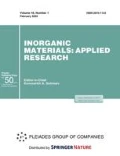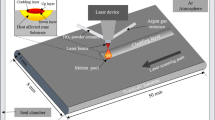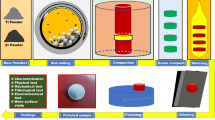Abstract
During the interaction of titanite with hydrochloric acid, a composite titanosilicate precipitate (TSP) of the composition TiO2 ⋅ (1.1–1.15) SiO2 ⋅ (0.8–0.85) H2O consisting of two phases is isolated—crystalline titanium dioxide of rutile modification and silica. It has been found that, during high-temperature treatment (850°C), particles of the hydrated precipitate condense with an increase in crystallinity and a decrease in Ssp almost twofold compared to freshly precipitated TSP, without sintering of particles and formation of new phases. Particles of the resulting composition are agglomerates of fragments of a fairly regular shape, which is characteristic of crystalline particles of titanium dioxide, the surface of which is coated with an amorphous silica shell. The study of the samples using an electron microscope and a laser analyzer showed that 90% of the particles are represented by a fairly narrow fraction 0.4–1 μm in size. The morphological properties of the particles of the composition, as well as its technical characteristics, including the ability to give a matte surface to transparent organic dispersions, allow one to conclude the prospects of its use as an effective filler in the manufacture of adhesives and sealants with dielectric properties and increased heat resistance. In addition, such a filler may find application in the manufacture of other functional materials.






Similar content being viewed by others
REFERENCES
Tyumeneva, T.Yu., Kogtenkov, A.S., Lukina, N.F., and Chursova, L.V., Advances in the development of adhesives and technologies for manufacturing mechanical rubber parts of aircraft, Polym. Sci.,Ser. D, 2014, vol. 7, no. 2, pp. 115–117.
Lukina, N.F., Dement’eva, L.A., Petrova, A.P., and Serezhenkov, A.A., Constructional and heat-resistant adhesives, Aviats. Mater. Tekhnol., 2012, no. 4, pp. 328–335.
Kablov, E.N., Strategic development of materials and technologies of their recycling until 2030, Aviats. Mater. Tekhnol., 2012, no. 5, pp. 7–17.
Trudy Mezhdunarodnoi nauchno-prakticheskoi konferentsii “Sovremennye dostizheniya v oblasti kleev i germetikov: Materialy, syr’e, tekhnologii” (Proc. Int. Sci.-Pract. Conf. “Modern Achievements in the Field of Adhesives and Sealants: Materials, Raw Materials, and Technologies”), Gladkov, O.V., Ed., Nizhny Novgorod, 2013.
Mudrov, O.A., Savchenko, I.M., and Shitov, V.S., Spravochnik po elastomernym pokrytiyam i germetikam v sudostroenii (Handbook on Elastomeric Coatings and Sealnts in Ship Building), Leningrad: Nauka, 1981.
Matveev, V.A., Krementskaya, I.P., and Maiorov, D.V., Ob ispol’zovanii amorfnogo kremnezema-produkta kislotnoi pererabotki nefelina v proizvodstve stroitel’nykh i tekhnicheskikh materialov (Use of Amorphous Silica—a Product of the Acidification of Nepheline in the Production of Construction and Technical Materials), 2012, Petrozavodsk, no. 260-V2012.
Chuppina, S.V., Physical and chemical patter of the formation and degradation of organosilicate coatings in the polyorganosiloxane-silicate-oxide system, Doctoral (Chem.) Dissertation, St. Petersburg: Inst. Silicate Chem., Russ. Acad. Sci., 2009.
Mitrofanova, G.V., Gromov, E.V., Artem’ev, A.V., and Chernousenko, E.V., The efficiency of integrated processing of poor apatite-nepheline ores containing rare and rare earth metals, Tsvetn. Met., 2018, no. 8, pp. 15–21.
Shchukina, E.S., Kiselev, Yu.G., and Gerasimova, L.G., Use of sphenite ores in technology of titanium compounds, Lakokras. Mater. Ikh Primen., 2017, nos. 7–8, pp. 34–43.
Sitnik, P.V. and Medkov, M.A., REE formation in hydrodifluoride processing of the perovskite concentrate, Theor. Found. Chem. Eng., 2016, vol. 50, no. 5, pp. 867–871.
Gerasimova, L.G., Petrov, V.B., Bychenya, Yu.G., and Okhrimenko, R.F., The interaction of sphene with hydrochloric acid, Khim. Tekhnol., 2005, no. 9, p. 26.
Lokshin, E.P. and Sednev, T.A., Features of the anatase transformation to rutile, Russ. J. Gen. Chem., 2011, vol. 81, no. 9, pp. 1749–1754.
Chuppina, S.V. and Zhabrev, V.A., Organosilikatnye materialy (Organosilicate Materials), St. Petersburg: Liteo, 2016.
Gerasimova, L.G., Nikolaev, A.I., Maslova, M.V., and Shchukina, E.S., Titanium-containing fillers. Production and properties, Mater.,Methods Technol., 2016, vol. 10, pp. 104–111.
Manakova, N.K., Motina, A.V., and Suvorova, O.V., The properties of porous granular materials based on intumescent shales and silica fume, Materialovedenie, 2018, no. 3, pp. 44–48.
Author information
Authors and Affiliations
Corresponding author
Additional information
Translated by Sh. Galyaltdinov
Rights and permissions
About this article
Cite this article
Gerasimova, L.G., Shchukina, E.S., Maslova, M.V. et al. Preparation and Characteristics of Titanium Silicate Filler for Functional Materials. Inorg. Mater. Appl. Res. 11, 903–907 (2020). https://doi.org/10.1134/S2075113320040103
Received:
Revised:
Accepted:
Published:
Issue Date:
DOI: https://doi.org/10.1134/S2075113320040103




